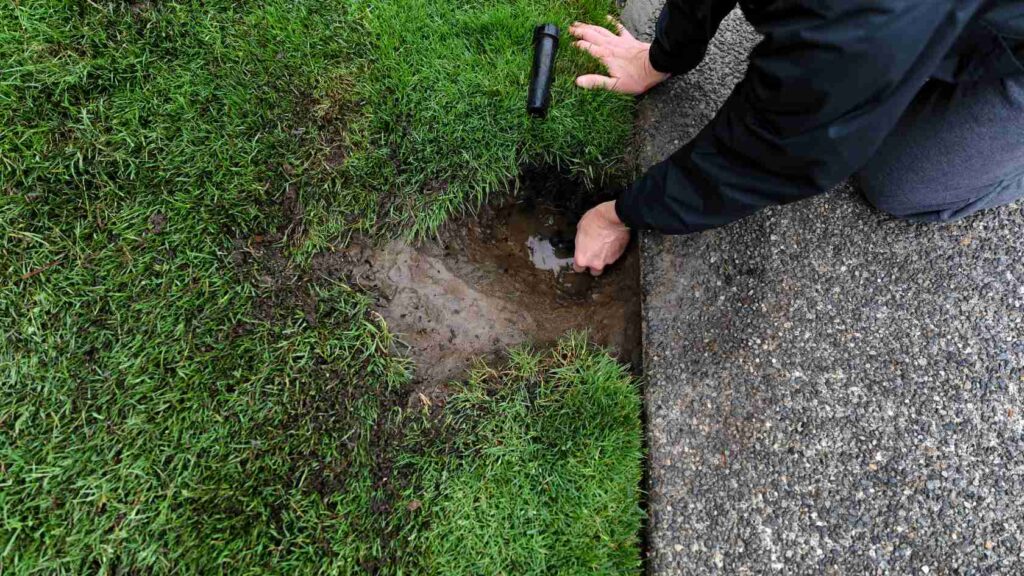Fixing Most Common Sprinkler Problems: A Homeowner’s Guide

Ever watched your sprinkler spit out water like a choking fountain? It’s as if it has lost its rhythm, forgotten how to dance in the morning sun. Welcome to the world of the most common sprinkler problems plus how to fix them. The green carpet we all dream of often gets interrupted by dry spots and brown patches, thanks to our faulty irrigation comrades.
I’ve been there too; staring at my wilting roses while scratching my head over a broken sprinkler head or wrestling with poor water pressure. You ain’t by yourself in this! And yes, these watering woes can be fixed!
This guide will serve as your trusty roadmap navigating through clogged heads and leaky valves right up until achieving that perfectly irrigated lawn paradise. So buckle up because an epic journey into the heartland of greener pastures awaits you!
Table Of Contents:
- Understanding Sprinkler Systems and Common Issues
- Poor Water Pressure and Its Impact on Sprinklers
- Dealing with Broken Sprinkler Heads and Leaks
- Addressing Clogged Sprinkler Heads and Debris Blockage
- Troubleshooting Issues with Sprinkler Valves & Controllers
- Overcoming Sprinkler System Installation & Design Flaws
- Addressing Lawn Damage and Brown Patches
- Solving Issues of Soggy Areas & Standing Water
- FAQs in Relation to Most Common Sprinkler Problems
- Conclusion
Understanding Sprinkler Systems and Common Issues
Sprinkler systems are like the beating heart of a green lawn, but common issues can throw them off beat. The controller is the key player in this orchestra, ensuring proper water flow and coverage.
The system’s design starts with sprinklers located strategically around your yard to provide maximum coverage. Different types of heads including spray heads for smaller areas or rotor heads for larger spaces serve unique roles.
Regular maintenance keeps things running smoothly, avoiding problems such as broken pipes disrupting water flow. But sometimes even with regular check-ups, you may encounter some common problems that need more than just a quick fix.
Recognizing Signs of Problems Early On
A healthy sprinkler system works efficiently without wasting any precious resource – water. Poor performance often indicates an underlying issue which needs immediate attention. It could be anything from poor water pressure affecting head height to leaks causing unnecessary wasted water spillage on sidewalks or driveways instead of nurturing your greens.
Your watering schedule plays an important role too – improper timing can lead to dry spots or overwatering causing soggy patches and potential damage to landscape equipment.
Digging Deeper into Common Sprinkler Problems
A lot goes behind maintaining those lush lawns we all admire so much; it’s not just about setting up a good irrigation services plan but also knowing how each part contributes towards achieving that goal – right from controlling the sprinkler valve down till where the rubber meets road (or rather grass.), i.e., the sprinkler head.
- Poor Water Pressure: A weak stream shooting out from your sprinklers isn’t doing your lawn any good. Often caused by clogged heads or broken pipes, this common issue reduces coverage and can lead to patchy lawns.
- Broken Sprinkler Heads: This is one of the most visible problems – water gushing out from a damaged head instead of following its designated path is not hard to spot.
- Clogged Sprinkler Head: Debris blocking the sprinkler’s nozzle can hamper its performance resulting in uneven watering. It’s like having a blocked nose; you just don’t breathe right.
Poor Water Pressure and Its Impact on Sprinklers
Water pressure is the heartbeat of your sprinkler system. But what happens when that pulse slows down? Let’s talk about it.
Identifying Signs of Poor Water Pressure
If you’re noticing patchy green areas or dry spots, it might be due to poor water pressure in your sprinkler heads. Another sign can be a weak spray from the heads, causing ineffective watering schedule for your lawn.
The cause could be as simple as debris blocking the pipes or more complex like broken pipes impacting water flow. Inconsistent water stream may also indicate an issue with head height leading to improper coverage.
Causes and Effects of Low Water Pressure
Poor water pressure is a common culprit behind unsatisfactory lawn coverage. Research shows this can result from blockages, faulty hardware, broken pipes or even issues related to overall system design.
A stuck valve could reduce water flow making the running smoothly feature seem redundant. Clogged sprinkler heads often contribute to this problem by disrupting proper water flow while a shorted-out motherboard in your controller will lead straight up mess up its watering schedule.
- Clogged Head: Debris buildup blocks the nozzle preventing proper functioning and resulting in less than adequate distribution pattern for optimal irrigation services.
- Faulty Hardware: Damaged valves disrupt control over how much waters goes where within each zone affecting uniformity throughout landscape equipment.
- Busted Pipes: No matter if they are made out of PVC or copper these are crucial conduits allowing water to reach different parts of yard without any obstructions.
Sprinkler Repair Tips:
It’s better to take preventive measures than to have to repair busted pipes. Regular checks can help avoid most of these issues and ensure proper water flow for a lush green lawn. If you’re unsure about doing it yourself, don’t hesitate to reach out to a professional sprinkler repair company.
Solutions for Improvement
Persistence is key to achieving success. Regular maintenance and periodic check-ups are crucial. They involve clearing any blockages or debris from the pipes and adjusting the head.
Dealing with Broken Sprinkler Heads and Leaks
The greenness of your lawn can be disrupted by broken sprinkler heads and leaks. These common issues, often due to defective valve diaphragms or improper installation, lead to increased water bills.
Recognizing Signs of a Broken Sprinkler Head
A broken sprinkler head is not hard to spot if you know what signs to look for. The first sign may be a sudden drop in water pressure during watering times. You might also notice uneven watering patterns on the lawn or see water spraying out from around the base of the head instead of from its top.
Sometimes, an odd noise accompanies these visual clues – perhaps a sputtering sound as air gets sucked into the line through cracks in the head. But remember, while these are common symptoms, they’re not definitive proof; it’s always best to take a closer look at any suspicious heads yourself before calling in professional help.
Finding and Fixing Leaks
Leaks are another common problem that requires attention sooner rather than later because they waste water and money. Start by checking your system regularly for soggy areas near pipes or spray heads which could indicate leaking joints or valves allowing water where it shouldn’t go.
If you find such spots but don’t feel confident about tackling them alone, professional irrigation services are just one call away. They’ll fix those leaks swiftly without damaging surrounding landscape equipment further.
Tackling Repairs: DIY vs Professional Help
You can sometimes handle smaller repairs like replacing worn-out washers yourself following some repair tips – especially handy if cost-saving is paramount right now.
To replace a damaged spray head, start by unscrewing the old one from its base. Next, screw on a new head (of the same model and brand to ensure proper water flow) onto the existing riser.
However, for more serious issues like leaks in underground pipes or valves stuck open due to debris blocking their mechanism, it’s wise to hire professional sprinkler repair services. They have tools and experience needed to handle complex repairs efficiently without risking further damage.
Addressing Clogged Sprinkler Heads and Debris Blockage
Let’s tackle one of the most common sprinkler problems – clogged heads. This issue can wreak havoc on your green lawn, leading to dry spots or inconsistent water flow.
The Impact of Clogged Heads on Water Flow
A clog in a sprinkler head disrupts the natural rhythm of your watering schedule. It hampers proper coverage, leaving some areas overwatered while others barely get a drop.
Clogs usually result from debris blocking the nozzle or filter screen within the spray head. You’ll notice that instead of an even stream, your broken sprinkler will either drip or give off a weak trickle.
The Causes Behind Blockages
Mud, sand particles, tiny pebbles – these are all culprits behind blockages. But they aren’t acting alone. Broken pipes often let soil and other small materials into your system which eventually find their way into the spray heads. Magnolia Plumbing has more info here.
Bugs too love cozying up inside sprinkle heads during dry spells. Come springtime when you start running water again… surprise. They’ve built homes right there.
Preventing Future Headaches: Maintenance Tips
To avoid future clogging issues make sure to perform regular maintenance checks; this saves time (and money) down the road. A good place to start is by cleaning out filters regularly as well as replacing worn-out ones every few months. This irrigation service provider offers excellent repair services for stuck valves too, should that be part of your problem.
Solution Time: Unclogging Your Sprinkler Heads
Let’s get our hands grubby. Let’s fix those clogged sprinklers.
First off, shut down the water supply. Then remove the top part of the spray head and pull out its internal components – be careful not to misplace anything.
If it’s debris causing blockage in your nozzle or filter screen; use a small wire brush or toothpick to dislodge debris gently.
Troubleshooting Issues with Sprinkler Valves & Controllers
Sprinkler valves and controllers are the brains of your irrigation system. They control water flow, making sure each sprinkler head gets just enough moisture to keep your lawn green.
Common Problems with Sprinkler Valves
Let’s start by understanding common problems with sprinkler valves. These tiny devices are responsible for regulating water pressure in your sprinklers. But when they go haywire, you might find yourself dealing with soggy patches or a bone-dry yard.
A stuck valve is one such issue that can cause a major headache. It prevents water from reaching certain areas of the garden while overwatering others. A shorted-out motherboard in an electronic controller could also lead to erratic watering patterns.
Pump buzzing indicates another problem that needs prompt attention – it signals an issue with the relay system inside your sprinklers’ pump station.
Importance of Proper Programming in Controllers
Moving on to sprinkler controllers, these gadgets give you complete control over watering schedules, ensuring proper coverage across different zones in your landscape equipment arsenal.
The common issues here usually stem from improper programming – if not set correctly, this leads to inefficient use of resources and even damages plant life due to either under-watering or over-watering.
- “The early bird catches the worm.” Just like our morning routines impact our day, setting up early morning schedules for most types of grasses helps avoid evaporation loss during peak sun hours.
- “Slow and steady wins the race.” For clay soils, setting your sprinklers to run for shorter periods but more frequently helps prevent runoff.
- “Timing is everything”. A poorly timed watering schedule can cause water waste and potentially lead to fines in drought-prone areas. You need a controller that lets you adjust schedules based on local regulations or seasonal changes.
When programmed correctly, a controller can save you time and reduce excessive water use. By programming a controller correctly, not only can you help the environment but also save money in the long term.
Overcoming Sprinkler System Installation & Design Flaws
Achieving a green lawn can be quite the task, especially when sprinkler system installation and design flaws get in the way. The wrong head height or poor placement of spray heads, for instance, often leads to uneven watering and patchy grass growth.
Let’s address these common problems head-on with some practical solutions that will have your sprinklers running smoothly again. With just a few tweaks here and there, you’ll ensure proper water flow throughout your yard.
Sprinkler Head Height Adjustment
The right sprinkler head height is crucial for achieving optimal coverage. Too low and they won’t reach far enough; too high could result in wasted water from overspray or evaporation.
To adjust them properly, follow these steps: Turn on the irrigation services so you can see where each spray lands. Adjust accordingly by either raising or lowering until it sprays directly over your landscape equipment without causing any wastage of water. Magnolia Plumbing Heating & Cooling, provides excellent resources on this topic if you need more guidance.
Clogged Heads And Broken Pipes
Poorly installed systems may lead to clogs due to debris blocking their path or broken pipes allowing unwanted leaks. Regular inspection helps detect such issues early before they turn into bigger headaches – like having dry spots around the garden because no sufficient watering takes place.
You should dislodge debris using a thin wire through its opening while applying gentle pressure downwards but not forceful enough as this might damage other components inside resulting in even worse problems. If upon inspection you find leaking pipes then replacing them becomes necessary at once since delays would only worsen an already bad situation further increasing costs involved later during repairs.
Proper Zoning
The sprinkler zone you select during installation greatly impacts the efficiency of your system. A common issue is placing too many heads in one zone, which can lead to poor water pressure and inefficient watering schedules.
Consider reducing the number of sprinkler heads per zone or installing a stronger pump to fix this problem. Monitor your system regularly to detect any changes.
Addressing Lawn Damage and Brown Patches
Many of us strive for a lush, green lawn. But it’s disheartening when you notice brown patches or areas of damage despite your best efforts. Often, these problems are due to issues with sprinkler head height or watering schedule.
Misjudged Sprinkler Head Height and Its Impact
An incorrect sprinkler head height can cause some serious troubles for your lawn. If the heads are too low, they might miss certain areas entirely, leaving them dry and barren. Conversely, if they’re set too high, water may pool around the sprinklers leading to oversaturated spots.
A common issue that arises from this is standing water which not only drowns plants but also becomes a breeding ground for mosquitoes in warm weather conditions. A healthy balance is needed here to ensure proper coverage without overdoing it.
The key stat here is pretty revealing – improper head height can lead directly to unevenly distributed water across your yard resulting in both missed areas as well as pooling zones. This increases the likelihood of grass becoming damaged by either drought stress or excessive moisture.
Finding Your Ideal Watering Schedule
Brown patches on lawns aren’t always about physical equipment like sprinkler heads. Sometimes it boils down to how often you’re running those sprinklers located around your property.
Your watering schedule plays an important role in maintaining a green lawn throughout changing seasons and weather patterns. Too much water causes soggy soil and root rot while insufficient irrigation leads to parched grass blades turning yellow then eventually brown.
In addition to these visual cues consider employing technology solutions such as smart controllers which adapt based on local climate data ensuring that your lawn receives the right amount of water at the right time.
Expert Tips to Fix Lawn Damage and Brown Patches
If you’re dealing with a case of brown patches or lawn damage, don’t fret. There are ways to bring back that healthy green color.
First off, you gotta double-check your sprinkler heads are set up right. A little tweak to their height can really boost the coverage. That way, every nook and cranny of your yard gets enough water.
Solving Issues of Soggy Areas & Standing Water
Wading through a mini pond in your backyard? That’s a clear sign you’re dealing with soggy areas and standing water, an all too common sprinkler problem. But don’t worry. We can get this fixed.
The Root Causes of Soggy Spots
Your lawn turning into the Everglades could be due to outdated equipment or improper design flaws. High water usage by a sprinkler system is often the culprit here – it might be time for more efficient replacements.
In some cases, there may be broken pipes allowing water to pool in certain spots rather than spreading evenly across your green spaces. Or perhaps, those pesky clogged heads are obstructing proper water flow and causing accumulation at unwanted places.
Finding Solutions for Wet Woes
If high-water use is making parts of your yard look like marshland, consider upgrading to efficient irrigation services. Modern systems not only control water better but also save on bills – two birds with one stone.
Busted pipes can create quite the mess. A quick fix involves replacing damaged sections while ensuring that new joints fit well together without leaks; however, this process does require some DIY skills and patience.
For our third suspect – blocked heads – regular maintenance comes handy: inspect them frequently and clean out any debris blocking their path to keep things running smoothly.
Standing Water = Breeding Grounds for Trouble
Apart from ruining your beautiful landscape equipment (and giving you squishy shoes), standing waters serve as open invitations for mosquitoes and other pests. Plus they waste precious resources while providing zero benefits to your lush green lawn or garden plants.
Let’s not forget the damage soggy spots can do to your sprinkler heads. Excess water pressure or standing water could cause broken heads, leading to even more watering woes.
Avoiding Future Fiascos
Proper sprinkler maintenance can really help in keeping your yard dry. It’s not just about preventing water buildup, but also maintaining the health of your grass and plants. A sprinkler system that covers every nook and cranny makes sure there are no overly damp spots. So, get ahead of the game by investing in a good quality irrigation setup for a worry-free, lush lawn.
When it comes to sprinkler problems, the question of whether to hire a professional or try DIY repairs often arises. The choice of whether to employ an expert or attempt DIY repairs for sprinkler issues is contingent on the particular circumstance, with both approaches having their own benefits.
Exploring DIY Repairs
For minor issues like adjusting head height for proper coverage, fixing clogged heads to ensure proper water flow, or replacing a broken head, DIY repairs may be within your capabilities. Successfully fixing these problems on your own can be satisfying.
However, there is a downside. If you lack experience with landscape equipment and repairs, you may unintentionally cause more harm than good. Improper fixes can lead to bigger issues, such as increased water waste due to leaky valves allowing excessive water flow.
The Benefits of Professional Services
A professional sprinkler repair company has the expertise and tools necessary for quick diagnosis and resolution. Their extensive knowledge of common sprinkler issues in different zones enables them to efficiently handle complex tasks that may take amateurs much longer – even an entire weekend.
Moreover, these professionals are trained to deal with potentially hazardous situations, such as shorted-out motherboards in controllers or handling stuck valves without causing further damage. These are tasks that not everyone is equipped to handle when attempting home repairs.
Knowing When to Seek Professional Help
If you encounter an issue that troubleshooting steps don’t resolve quickly enough, such as recurring dry spots despite adjustments to the watering schedule, it’s best to consider hiring irrigation services right away. This will help prevent the risk of damaging expensive parts through trial-and-error methods.
FAQs in Relation to Most Common Sprinkler Problems
What is wrong with my sprinkler system?
If your sprinkler isn’t working, check for low water pressure, clogged heads, leaks or broken parts. Controller issues could also be at play.
How do you diagnose a sprinkler problem?
To spot problems with your sprinklers, look out for uneven watering patterns. Examine the system components regularly and watch out for unusual changes in water usage.
How do you fix a main sprinkler line?
You can patch small leaks on the main line using repair couplings. For larger breaks or damage though, it might be best to replace that section of pipe entirely.
How do you fix sprinklers that don’t pop up all the way?
Clean debris from around the head if it doesn’t rise fully. Adjusting spring tension can help too. But sometimes replacing an old worn-out head is necessary.
Conclusion
Conquering the most common sprinkler problems plus how to fix them isn’t a Herculean task. It boils down to recognizing the issue and taking steps.
Remember, poor water pressure can disrupt your lawn paradise. Check for blockages or broken pipes, and don’t hesitate to seek professional help if needed.
Clogged heads? Clear debris from your sprinklers regularly. This simple habit can ensure smooth water flow.
Beware of leaky valves and damaged heads! Quick repairs here will save you both money on bills and tears over wilting roses.
The key is regular maintenance; it not only keeps the green in your lawn but also saves time, effort, and resources in the long run!
As an Amazon Associate, we earn from qualifying purchases. Affiliate links help support our work and allow us to continue providing free content. If you make a purchase through an affiliate link, we receive a small percentage of the sale at no extra cost to you.
The DIY repair advice on this site is for informational purposes only. The content aims to be helpful but cannot guarantee success or substitute professional advice. Any repairs involve some risk, so readers assume all liability and responsibility for their actions. Safety should be the top priority. If unsure about any procedure, first consult a qualified professional to determine suitability.
- Sprinkler Rebate Guide
- Slash Your Water Bill and Save the Planet with Sprinkler Rain Sensors!
- How to Revive a Lawn: Bringing Your Drought-Stricken Lawn Back to Life
- Sprinkler Repair Costs: The Shocking Truths You Need to Know!
- Gardeners Won’t Believe These Raised Bed Irrigation System Hacks!
- 11 Shocking Secrets to Buying the Perfect Sprinkler Heads
- A Comprehensive Guide on How to Adjust the Rainbird 5000 Sprinkler Head
- The Complete Step-by-Step Guide to Design a Sprinkler System
- Residential Sprinkler Head Types: A Comprehensive Guide
- Thank You For Subscribing




